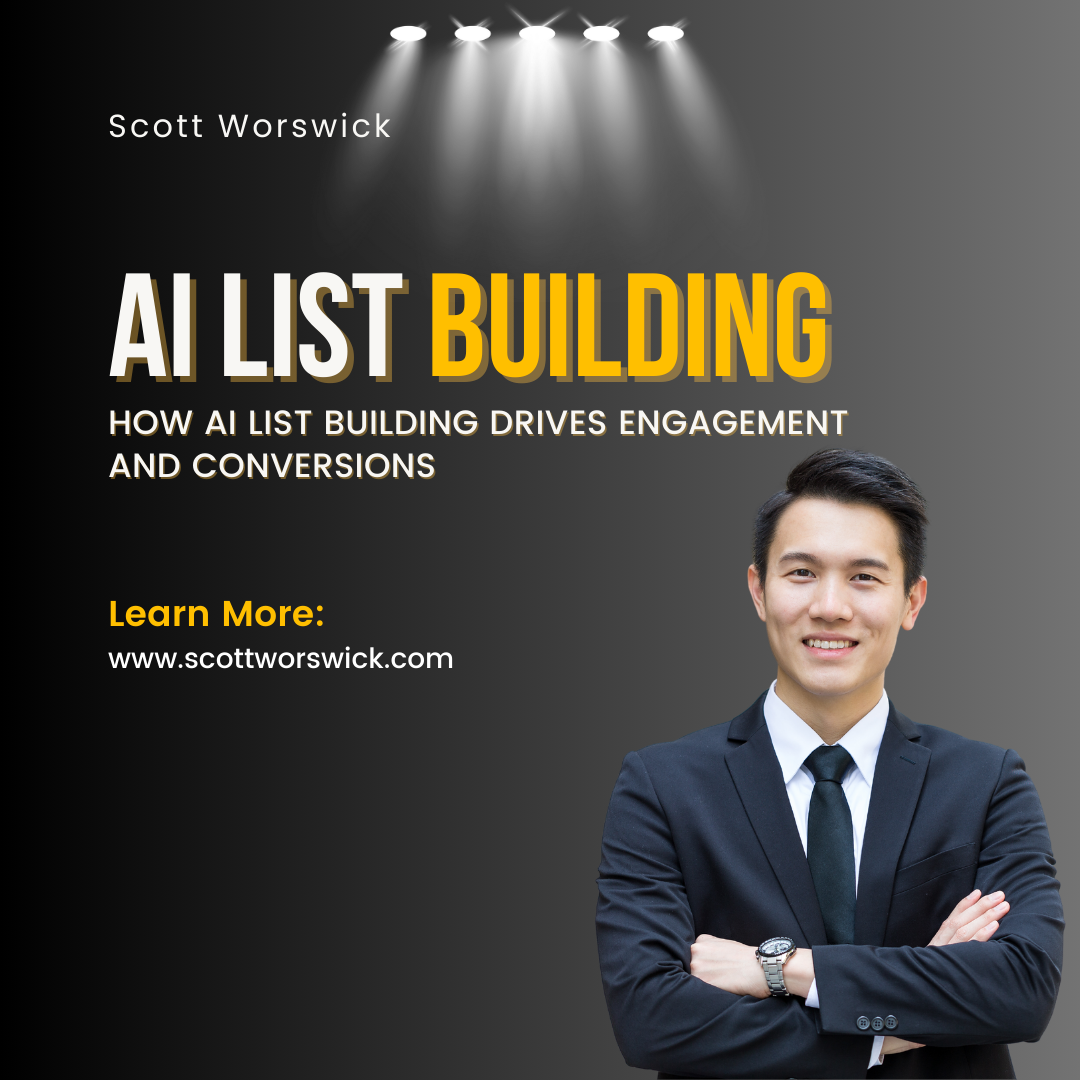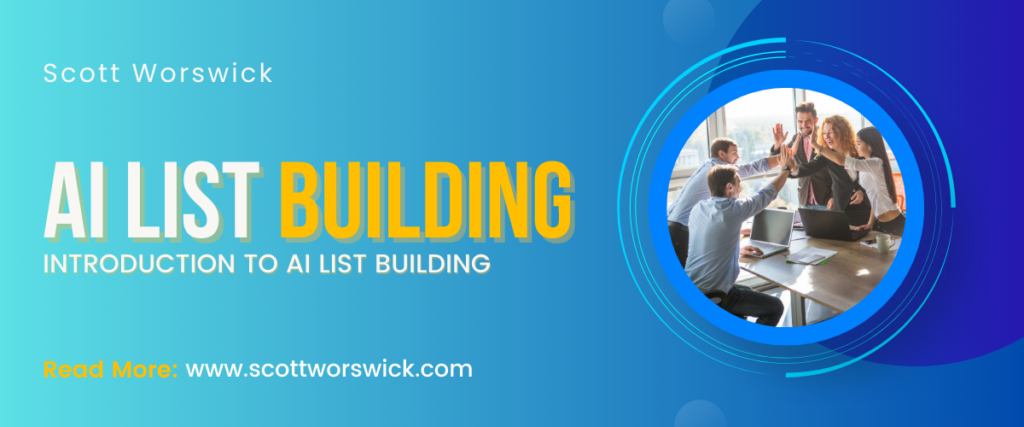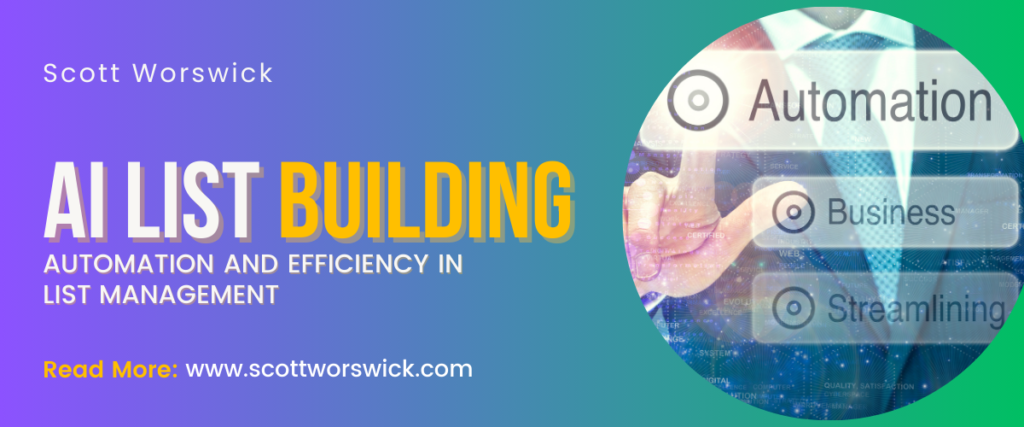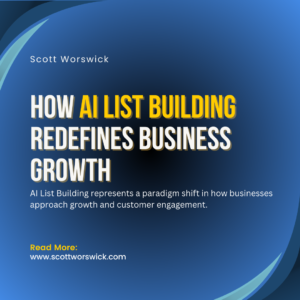In the rapidly evolving landscape of digital marketing, businesses are constantly seeking innovative ways to engage their audience and drive conversions. One of the most transformative developments in recent years is the advent of AI List Building. By harnessing the power of artificial intelligence, companies can create highly targeted email lists that cater to the specific preferences and behaviors of their customers. This technological advancement not only streamlines the list-building process but also significantly enhances the effectiveness of email marketing campaigns.
AI List Building leverages sophisticated algorithms to analyze vast amounts of data, including customer demographics, purchasing history, online behavior, and social media interactions. This in-depth analysis allows businesses to segment their audience with unprecedented precision, ensuring that each email is relevant and personalized. As a result, recipients are more likely to engage with the content, leading to higher open rates, click-through rates, and ultimately, conversions. The ability to deliver the right message to the right person at the right time is a game-changer in the world of email marketing.
Furthermore, AI List Building offers a level of automation and efficiency that is impossible to achieve through manual methods. Traditional list-building processes can be time-consuming and prone to errors, but AI automates these tasks, ensuring that email lists are continuously updated and optimized. This not only saves valuable time for marketers but also allows them to focus on strategic initiatives and creative endeavors. In a competitive digital marketplace, the adoption of AI List Building can provide businesses with a significant edge, enabling them to foster deeper connections with their audience and achieve remarkable marketing outcomes.
Table of Contents
1. Introduction to AI List Building
In the dynamic realm of digital marketing, the ability to connect with potential customers through personalized communication is a key driver of success. One of the most groundbreaking advancements enabling this personalized approach is AI List Building. This innovative technique leverages the power of artificial intelligence to create, manage, and optimize email lists, ensuring that marketing messages reach the most relevant audience segments. By integrating AI into the list-building process, businesses can significantly enhance their engagement and conversion rates, transforming their email marketing strategies from broad-based efforts into precision-targeted campaigns.
AI List Building stands out by its ability to analyze and interpret vast quantities of data with incredible speed and accuracy. Traditional methods of list building often rely on manual segmentation and outdated data, which can lead to inefficient and ineffective marketing efforts. In contrast, AI List Building utilizes advanced algorithms to process real-time data from various sources such as customer browsing history, purchase patterns, and social media activity. This comprehensive analysis enables marketers to create detailed customer profiles and segment their audience with unprecedented granularity, ensuring that each email is tailored to the recipient’s specific interests and behaviors.
The personalization capabilities of AI List Building extend far beyond basic demographic information. AI systems can identify subtle patterns and preferences within the data, allowing for a level of customization that manual processes simply cannot achieve. For example, AI can determine the optimal times to send emails, the types of content that resonate most with different segments, and the frequency of communication that maximizes engagement without overwhelming the recipient. This depth of personalization fosters a more meaningful connection between the brand and its audience, leading to higher open rates, increased click-through rates, and ultimately, greater conversion rates.
Moreover, the efficiency gains from AI List Building cannot be overstated. Automating the list-building process not only saves time and reduces the risk of human error but also ensures that email lists are always up-to-date and optimized for maximum impact. Marketers can redirect their efforts from tedious data management tasks to more strategic and creative initiatives, such as crafting compelling content and designing engaging campaigns. In today’s competitive digital marketplace, adopting AI List Building provides businesses with a critical advantage, enabling them to deliver highly relevant and timely messages that drive engagement and conversions, thereby achieving remarkable marketing outcomes.
2. The Importance of Targeted Email Lists
In the competitive landscape of digital marketing, the effectiveness of email campaigns is largely determined by the relevance of the messages sent to recipients. Targeted email lists play a crucial role in ensuring that marketing communications resonate with the audience, significantly enhancing engagement and conversion rates. By focusing on the specific interests and behaviors of different customer segments, businesses can deliver personalized content that captures attention and drives action. This is where AI List Building becomes indispensable, as it automates the creation and maintenance of highly targeted email lists, enabling marketers to reach the right people with the right messages at the right time.
The importance of targeted email lists lies in their ability to improve customer experience. When recipients receive emails that align with their preferences and needs, they are more likely to open, read, and interact with the content. This personalized approach not only boosts engagement but also fosters a sense of loyalty and trust towards the brand. Targeted emails are far more effective than generic mass emails, which often end up being ignored or marked as spam. By utilizing AI List Building, businesses can ensure that their email campaigns are precisely tailored, thereby maximizing the impact and return on investment (ROI) of their marketing efforts.
Furthermore, targeted email lists contribute to better resource allocation and higher conversion rates. Marketing budgets and efforts are finite, and it is essential to utilize them efficiently. By focusing on well-defined audience segments, businesses can avoid wasting resources on uninterested or irrelevant recipients. AI List Building facilitates this by continuously analyzing and updating customer data, ensuring that the email lists remain relevant and accurate. This dynamic approach allows marketers to adapt to changing customer behaviors and preferences, maintaining the effectiveness of their campaigns over time. As a result, businesses can achieve higher conversion rates, as their messages reach an audience that is more likely to engage and convert, ultimately driving revenue growth and business success.
3. How AI Analyzes Consumer Data
The cornerstone of effective AI List Building lies in the sophisticated analysis of consumer data. AI technology excels at processing vast amounts of information quickly and accurately, transforming raw data into actionable insights. This process begins with data collection from multiple sources, including website interactions, social media activities, purchase histories, and email engagement metrics. By integrating these diverse data points, AI creates comprehensive profiles for each consumer, providing a 360-degree view of their behaviors, preferences, and needs. This holistic understanding is essential for segmenting audiences and tailoring marketing strategies to individual customers.
AI’s ability to analyze consumer data extends beyond mere data aggregation. Advanced machine learning algorithms delve into the intricacies of consumer behavior, identifying patterns and predicting future actions. For instance, AI can determine which products a customer is likely to be interested in based on their past purchases and browsing history. It can also recognize the optimal times and channels for communication, ensuring that marketing messages are delivered when recipients are most receptive. This predictive capability is a game-changer in AI List Building, as it allows marketers to proactively address consumer needs and preferences, significantly enhancing engagement and conversion rates.
Moreover, AI continually refines its analysis through iterative learning processes. As new data flows in, AI systems update their models, adjusting to evolving consumer behaviors and market trends. This dynamic approach ensures that the insights derived from data analysis remain relevant and accurate over time. Additionally, AI can identify anomalies and shifts in consumer behavior that may indicate emerging trends or changing preferences. By staying ahead of these changes, businesses can adapt their marketing strategies promptly, maintaining their competitive edge. Ultimately, the deep and continuous analysis of consumer data by AI not only drives more effective list building but also fosters a deeper understanding of the audience, paving the way for more personalized and impactful marketing campaigns.
4. Enhancing Personalization Through AI
Personalization has become a cornerstone of effective digital marketing, and AI is at the forefront of making this possible. By leveraging AI List Building, businesses can enhance personalization to an unprecedented degree, creating highly individualized customer experiences. AI’s capability to analyze extensive data sets enables it to identify unique patterns and preferences within a customer base. This information is then used to tailor marketing messages that resonate on a personal level, ensuring that each communication feels bespoke rather than generic. The result is a more engaged audience that feels understood and valued by the brand.
AI-driven personalization goes beyond simply addressing a customer by their first name in an email. It involves understanding the nuances of a customer’s behavior, preferences, and purchase history. For instance, AI can recommend products based on past purchases or suggest content that aligns with a user’s interests. This level of detail in personalization creates a seamless and relevant experience for the customer, which significantly boosts engagement rates. When customers receive content that is directly relevant to them, they are more likely to interact with it, leading to higher open rates, click-through rates, and ultimately, conversions.
Moreover, AI enables dynamic content personalization. This means that the content of an email can change in real-time based on the recipient’s current behavior or location. For example, a customer browsing winter coats on a retail website might receive an email featuring a curated selection of winter apparel, complete with personalized discounts or offers. This real-time personalization ensures that marketing messages are always relevant and timely, catering to the immediate interests of the customer. By using AI List Building, businesses can maintain a continuous dialogue with their customers, adapting to their needs as they evolve.
The benefits of enhancing personalization through AI extend beyond immediate engagement and conversions. Personalized marketing fosters a deeper connection between the customer and the brand, cultivating long-term loyalty. Customers who feel that a brand understands and anticipates their needs are more likely to remain loyal and make repeat purchases. Furthermore, they are more likely to advocate for the brand, sharing their positive experiences with others. This word-of-mouth promotion is invaluable, as it not only brings in new customers but also enhances the brand’s reputation. In essence, AI-driven personalization transforms marketing efforts into a powerful tool for building lasting customer relationships, driving sustained engagement, and achieving higher conversion rates.
5. Automation and Efficiency in List Management
In the realm of digital marketing, managing email lists efficiently is crucial for maintaining high engagement and conversion rates. AI List Building brings a significant advantage by automating the list management process, ensuring that email lists are always up-to-date and optimized for performance. This automation not only saves time but also enhances the accuracy and effectiveness of email campaigns. By leveraging AI, businesses can streamline their list management practices, allowing marketers to focus more on strategic initiatives rather than the mundane tasks of data entry and maintenance.
AI-driven automation handles various aspects of list management, including data collection, segmentation, and updating. Traditionally, these tasks are labor-intensive and prone to human error. With AI, data is continuously collected from multiple sources, such as website interactions, purchase histories, and social media activities. This data is then analyzed in real-time, ensuring that the email lists are segmented based on the latest information. AI List Building ensures that the right messages reach the right audience segments, which is critical for maximizing engagement and conversion rates.
The efficiency of AI in list management also extends to maintaining the cleanliness and relevance of email lists. AI systems can automatically detect and remove inactive or invalid email addresses, reducing the risk of bounces and improving deliverability rates. Furthermore, AI can identify and merge duplicate entries, ensuring that each contact is unique and accurate. This continuous refinement of email lists not only enhances the effectiveness of email campaigns but also improves sender reputation, which is crucial for avoiding spam filters and reaching the inbox.
Additionally, AI enables more sophisticated list management strategies through predictive analytics. By analyzing past behaviors and trends, AI can predict which subscribers are most likely to engage with future campaigns. This insight allows marketers to prioritize high-value contacts and tailor their strategies accordingly. For instance, AI can identify subscribers who are showing signs of disengagement and trigger re-engagement campaigns specifically designed to win them back. This proactive approach, powered by AI List Building, ensures that marketing efforts are not only efficient but also strategically targeted to drive maximum engagement and conversions.
Overall, the automation and efficiency brought by AI List Building transform list management from a cumbersome process into a streamlined, intelligent system. Businesses can maintain highly accurate and relevant email lists, ensure effective segmentation, and deploy targeted campaigns that resonate with their audience. The result is a more efficient use of resources, higher engagement rates, and improved conversion outcomes, making AI an indispensable tool in modern digital marketing.
6. Predictive Analytics for Better Targeting
Predictive analytics has emerged as a transformative force in digital marketing, providing unparalleled insights into consumer behavior and preferences. By leveraging predictive analytics, AI List Building enables marketers to anticipate future actions of their audience based on historical data. This foresight allows for more accurate and effective targeting, ensuring that marketing messages are not only timely but also relevant. By predicting what products or services customers might be interested in next, businesses can tailor their communications to meet these needs proactively, significantly enhancing engagement and conversion rates.
The power of predictive analytics in AI List Building lies in its ability to process and analyze vast amounts of data from multiple sources. AI algorithms examine patterns in customer interactions, purchase histories, and even social media activity to forecast future behaviors. For example, if a customer has frequently purchased health supplements in the past, predictive analytics can suggest that they might be interested in new or related products. This level of insight enables businesses to segment their audience with precision, targeting specific groups with personalized offers that are more likely to resonate and drive action.
Moreover, predictive analytics helps in optimizing the timing and content of marketing messages. By understanding when customers are most likely to engage, businesses can schedule their emails to arrive at the optimal moment, increasing the chances of the emails being opened and acted upon. Additionally, predictive analytics can refine the content itself, suggesting which types of messages or offers have historically driven the most engagement for similar customers. This dynamic and data-driven approach, powered by AI List Building, ensures that marketing efforts are continuously optimized for better performance, ultimately leading to higher engagement and conversion rates.
In essence, predictive analytics enhances AI List Building by transforming vast datasets into actionable insights that drive more precise targeting. This results in more personalized, timely, and relevant marketing communications that resonate deeply with the audience. As a result, businesses can achieve higher engagement levels, improved customer satisfaction, and greater conversion rates, making predictive analytics an indispensable tool in the digital marketer’s arsenal.
7. Reducing Churn with AI List Building
Customer churn is a significant challenge for businesses, as retaining existing customers is often more cost-effective than acquiring new ones. AI List Building offers a powerful solution to this problem by identifying at-risk customers and implementing targeted strategies to retain them. Through sophisticated data analysis, AI can detect patterns and behaviors that signal potential churn, such as decreased engagement or changes in purchasing habits. By pinpointing these early warning signs, businesses can proactively address the issues that might lead to customer attrition, thereby reducing churn rates and fostering long-term loyalty.
AI List Building enhances retention efforts by personalizing re-engagement strategies for at-risk customers. Once AI identifies these customers, it can tailor specific messages and offers designed to win them back. For instance, personalized emails with special discounts, exclusive content, or tailored product recommendations can reignite interest and engagement. Moreover, AI can optimize the timing of these communications, ensuring that messages reach customers when they are most likely to respond positively. This targeted approach not only helps in retaining customers but also strengthens their connection to the brand, making them feel valued and understood.
Additionally, AI List Building facilitates continuous improvement in retention strategies through ongoing data analysis and feedback. By tracking the effectiveness of various re-engagement tactics, AI can determine which approaches yield the best results for different customer segments. This iterative learning process allows businesses to refine their strategies continually, enhancing their ability to reduce churn over time. Ultimately, the integration of AI in list building provides a robust framework for understanding and mitigating customer churn, driving sustained engagement and conversions, and ensuring a stable and loyal customer base.
8. Increasing Conversion Rates with AI
Increasing conversion rates is a primary goal for any marketing strategy, and AI List Building offers a cutting-edge solution to achieve this objective. By leveraging the power of artificial intelligence, businesses can enhance their understanding of customer behaviors and preferences, leading to more effective and targeted marketing campaigns. AI analyzes vast amounts of data, such as browsing history, purchase patterns, and engagement metrics, to create detailed customer profiles. This granular level of insight allows marketers to design highly personalized messages that resonate with specific audience segments, significantly increasing the likelihood of conversions.
One of the key ways AI List Building boosts conversion rates is through the optimization of email content and timing. AI algorithms can predict the type of content that is most likely to appeal to different customer segments based on past interactions. For example, a customer who frequently purchases eco-friendly products might receive emails highlighting sustainable product lines and special promotions. Additionally, AI can determine the optimal times to send these emails, ensuring they reach recipients when they are most likely to be active and engaged. This precise targeting and timing maximize the chances of the email being opened and acted upon, leading to higher conversion rates.
Moreover, AI continuously learns and adapts to changing customer behaviors, refining its strategies to improve conversion outcomes over time. Through A/B testing and performance analysis, AI can identify which tactics are most effective and adjust campaigns accordingly. This dynamic approach ensures that marketing efforts remain relevant and impactful, even as market conditions and consumer preferences evolve. By integrating AI List Building into their marketing strategies, businesses can not only drive immediate improvements in conversion rates but also maintain a competitive edge by staying ahead of trends and consistently meeting customer expectations.
9. The Role of AI in A/B Testing
A/B testing is a fundamental tool in optimizing marketing campaigns, and AI List Building has revolutionized this process by introducing sophisticated algorithms that streamline and enhance the testing process. Traditionally, A/B testing involves comparing two versions of a marketing asset, such as an email or a landing page, to determine which one performs better in terms of engagement and conversions. AI List Building automates much of this process, allowing marketers to test multiple variations simultaneously and analyze the results in real-time. By leveraging AI algorithms, businesses can quickly identify the most effective strategies for engaging their audience and driving conversions.
The role of AI in A/B testing extends beyond simply analyzing the performance of different variations. AI can also generate insights and recommendations based on the data collected during testing. For example, AI algorithms can identify patterns and trends within the data, helping marketers understand which factors contribute most to successful outcomes. This deeper level of analysis enables businesses to make informed decisions about future marketing strategies, refining their approach to maximize engagement and conversions. Additionally, AI can automate the implementation of these insights, allowing for rapid iteration and continuous improvement in marketing campaigns.
Furthermore, AI List Building enhances the scalability and efficiency of A/B testing by optimizing the allocation of resources. With AI, marketers can prioritize testing efforts based on factors such as audience segments, campaign objectives, and expected outcomes. This targeted approach ensures that testing resources are directed towards areas where they are most likely to yield meaningful results. By streamlining the testing process and providing actionable insights, AI List Building empowers businesses to iterate more quickly, refine their strategies, and ultimately drive higher engagement and conversions.
10. Case Studies: Success Stories of AI List Building
Case studies provide tangible evidence of the effectiveness of AI List Building in driving engagement and conversions for businesses across various industries. One notable success story comes from an e-commerce retailer that implemented AI List Building to enhance their email marketing efforts. By leveraging AI algorithms to analyze customer data and behavior, they were able to segment their email lists more effectively and deliver highly personalized content to their subscribers. As a result, they experienced a significant increase in engagement metrics, including open rates and click-through rates. Moreover, the personalized approach led to a substantial boost in conversion rates, with more subscribers making purchases as a direct result of the targeted emails.
In another case study, a software-as-a-service (SaaS) company utilized AI List Building to optimize their lead generation efforts. By analyzing data from their website, social media channels, and customer interactions, they were able to identify high-value leads and prioritize them for follow-up. The AI algorithms helped them understand which leads were most likely to convert into paying customers, allowing the sales team to focus their efforts on the most promising opportunities. As a result, the company saw a significant increase in conversion rates and a decrease in the time it took to close deals, ultimately leading to higher revenue and business growth.
Additionally, a hospitality industry case study showcases the power of AI List Building in driving engagement and bookings. A hotel chain implemented AI algorithms to analyze guest data and preferences, allowing them to personalize their email marketing campaigns and promotional offers. By sending targeted emails to specific customer segments based on their preferences and past booking history, they were able to increase engagement and encourage repeat visits. The AI-driven approach also enabled them to optimize room rates and availability, resulting in higher occupancy rates and revenue per available room (RevPAR). Overall, these case studies illustrate how AI List Building can deliver tangible results by enhancing engagement and driving conversions across diverse industries and business models.
11. Future Trends in AI List Building
Looking ahead, the future of AI List Building holds exciting possibilities as advancements in technology continue to shape the landscape of digital marketing. One emerging trend is the integration of AI-powered chatbots into list-building strategies. These intelligent chatbots can engage with website visitors in real-time, collecting valuable data and preferences that can be used to personalize future communications. By leveraging natural language processing and machine learning algorithms, businesses can provide a seamless and interactive experience for users while simultaneously gathering insights to enhance their email marketing efforts.
Another future trend is the expansion of AI List Building beyond email marketing to encompass other channels such as social media and messaging apps. As consumers increasingly communicate and engage with brands through these platforms, AI algorithms will play a crucial role in analyzing user interactions and behaviors to build targeted audience lists. This omnichannel approach allows businesses to reach customers where they are most active, delivering personalized messages across multiple touchpoints to maximize engagement and conversions. Additionally, AI-powered tools for content creation and optimization will become increasingly prevalent, enabling marketers to create more compelling and relevant content that resonates with their audience.
Furthermore, the future of AI List Building will be characterized by greater integration with customer relationship management (CRM) systems and marketing automation platforms. By combining AI-driven insights with existing customer data and workflows, businesses can create seamless end-to-end experiences that nurture leads and drive conversions. AI algorithms will play a central role in identifying high-value leads, predicting customer behaviors, and automating personalized communications at scale. This integration empowers marketers to deliver hyper-targeted campaigns that are tailored to the individual needs and preferences of each customer, leading to higher engagement and conversion rates.
Moreover, as AI technologies continue to evolve, we can expect to see advancements in predictive analytics and machine learning algorithms that further enhance the capabilities of AI List Building. These advancements will enable businesses to anticipate customer needs and behaviors with even greater accuracy, allowing for more proactive and personalized marketing strategies. By staying at the forefront of these developments and embracing AI List Building as a central pillar of their marketing efforts, businesses can position themselves for success in an increasingly competitive digital landscape, driving higher engagement, conversions, and long-term customer loyalty.
Conclusion
AI List Building represents a groundbreaking advancement in digital marketing, offering businesses a powerful tool to enhance engagement and drive conversions. By harnessing the power of artificial intelligence, companies can create highly targeted email lists that cater to the specific preferences and behaviors of their audience. AI List Building enables businesses to analyze vast amounts of data with precision, allowing for the creation of personalized marketing campaigns that resonate deeply with individual customers. This level of personalization not only increases engagement but also fosters long-term customer loyalty, ultimately leading to higher conversion rates and sustained business growth.
Furthermore, AI List Building streamlines the process of list management, automating tedious tasks such as data collection, segmentation, and updating. This automation not only saves time but also ensures that email lists are continuously optimized for performance. By leveraging predictive analytics and machine learning algorithms, businesses can anticipate customer needs and behaviors, enabling them to deliver timely and relevant messages that drive action. Additionally, AI List Building facilitates continuous improvement through A/B testing and performance analysis, allowing marketers to refine their strategies and achieve even better results over time.
As we look to the future, the potential of AI List Building to revolutionize digital marketing is boundless. With advancements in technology and data analytics, businesses can expect even greater levels of personalization and efficiency in their marketing efforts. By embracing AI List Building as a central component of their strategies, businesses can stay ahead of the curve and achieve remarkable outcomes in engagement and conversions. In a competitive digital landscape, AI List Building is not just a tool but a catalyst for innovation and success, empowering businesses to connect with their audience in more meaningful ways and drive sustainable growth.







Pingback: Why AI List Building is Essential in Today's Competitive Market -